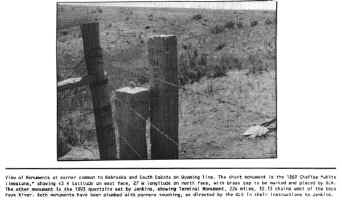|
 Article taken from "Backsights"
Magazine published by Surveyors Historical Society
Article taken from "Backsights"
Magazine published by Surveyors Historical Society
|
SHOVELS
AND PLUMB BOBS
by Rollin C. Curd
On June 19, 1988, members
of the Fall River and Sioux County Historical Societies, accompanied by five
land surveyors, journeyed to the common corner of Nebraska and South Dakota on
the Wyoming line. Along the way, we visited 10 historical ranches and two
abandoned post office sites and the Cheyenne-Deadwood Freight Station.
Upon arrival at the state
corner, the two monuments were viewed and photographed by many of the 56 persons
traveling on the annual Sioux County Historical Trek. Surveyors Dennis
Bland, from Cheyenne; Gene Thompson and Kent Kennedy, from Lincoln; Bruce Jensen
from Valentine; and Rollin Curd from Chadron, assisted by Historical Society
members using shovels, bars, lariats and man power, moved the two monoliths to
their original plumb positions. Surveyor plumb bobs were used to check the
finished work.
 The
first "white limestone monument" was set by Oliver N. Chaffee in his
1869 survey for the Nebraska-Wyoming line. The "27o W.
L." inscribed on the north face means longitude 27o west of
Washington, D. C.. The Washington, D. C. system of measuring longitude was
practiced between 1850 and 1912. Today, longitude is measured from
Greenwich, England, and our location is approximately 104o. We
see "138M, 22 ch., 67 lks." on the south face. This means 138
miles, 22 chains and 67 links north of Point of Beginning, the SE corner of
Wyoming. The
first "white limestone monument" was set by Oliver N. Chaffee in his
1869 survey for the Nebraska-Wyoming line. The "27o W.
L." inscribed on the north face means longitude 27o west of
Washington, D. C.. The Washington, D. C. system of measuring longitude was
practiced between 1850 and 1912. Today, longitude is measured from
Greenwich, England, and our location is approximately 104o. We
see "138M, 22 ch., 67 lks." on the south face. This means 138
miles, 22 chains and 67 links north of Point of Beginning, the SE corner of
Wyoming.
When Chaffee set the
monument, he wrote in his field notes the following: "It is
surrounded by a mound of earth and stone 7 ft. in diameter at its base, 6 ft. in
diameter at top and 3.5 ft. high. It stands in a small broken hollow
without any natural objects available for witnesses and nothing striking to the
attention. The surfaces rise towards the N., E., and W. and furnishes
nothing which would attract attention or furnish material for a sketch.
The soil is clay of the poorest quality."
Astronomer Chauncey Wiltse
received a General Land Office contract in 1874 to survey the Nebraska-South
Dakota Boundary, beginning at the intersection of latitude 43o and
the Keya Paha River and ending at the Chaffee monument. Wiltse measured
the distance 224 miles, 12.13 chains along the 43rd parallel. He set
7-foot by 6-inch by 6-inch cottonwood or cedar posts and charred blocks at
one-mile intervals and established four astronomical stations along the
line. Only one of the astronomical stations has been found; it is located
north of Chadron.
In 1880 Robert Harvey was
the next surveyor to come on the scene when he surveyed for the 7th Guide
Meridian, located four miles east of and parallel to the Nebraska-Wyoming line.
George L. Fairfield
subdivided T35N, R47W in 1883 and created another state corner 450 feet north of
Chaffee's monument. He created another Nebraska-South Dakota line between
the Wyoming line and milepost 221.
In 1887 Rollin Reaves
surveyed north from the Chaffee monument to latitude 46o, marking the
Wyoming-South Dakota line.
A surveyor George W.
Cooley started section surveys in South Dakota in 1890. He ignored
Fairfield's survey and used the Chaffee and Wiltse surveys.
The General Land Office
issued a contract to Joseph Jenkins in 1893 to retrace Wiltse's survey and place
quartzite monuments at half-mile intervals beginning at the Keya Paha River,
running west to Chaffee's monument, then running east from Keya Paha river to
the Missouri River.
Today we view the
quartzite monument by Jenkins. These monuments were quarried and marked by
stone masons in Sioux Falls, S. D., area and shipped by rail to towns along the
border. Teamsters transported these stone monoliths to the
surveyors. The monuments are marked SD on the north face, N. on the south
face and the miles west or east of the Keya Paha River.
In 1904 U. S. Surveyor
Edward F. Stahle started the survey for the Wyoming-South Dakota boundary at the
Chaffee monument. In 1908 he retraced the Wyoming-Nebraska boundary and
set granite posts for mileposts and re-established the closing corners by
setting brass caps.
In 1922 Robert Harvey, a
past Nebraska state surveyor, wrote a letter to the General Land Office bringing
to their attention the two locations for common corner to three states.
The General Land Office and the Law Review Board held that Fairfield's corner
was fraudulent and his line easterly to MP 221 was null and void.
Plans are underway to
complete the restoration by September 6, 1989, at an estimated cost of $3,000.
Since the two monoliths
are located on the edge of a ravine, an earth berm is required to stabilize the
soil and discourage erosion. A commemorative brass cap will be set in the
original Chaffee monument and a suitable plaque will be dedicated at the site
120 years after Chaffee set the "white limestone monument."
| 